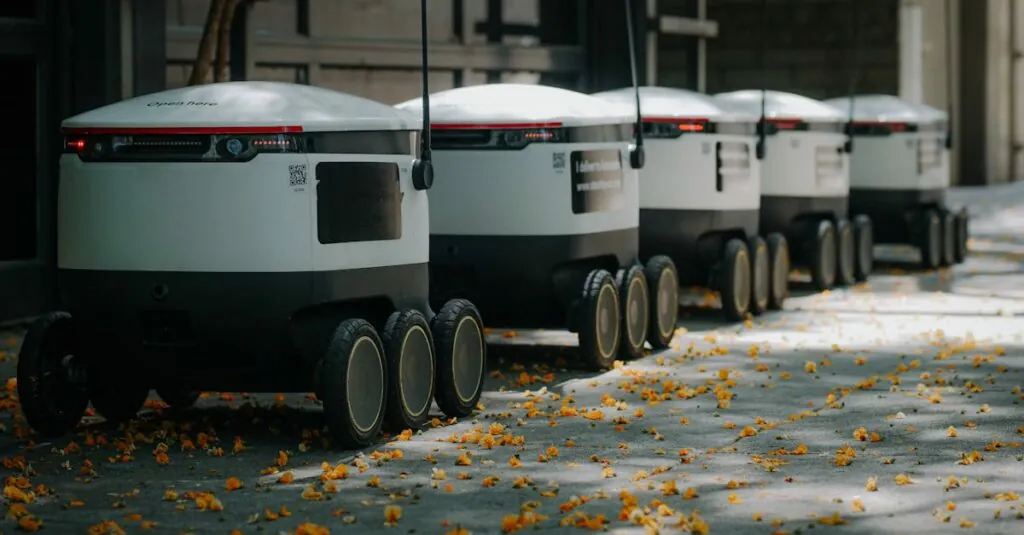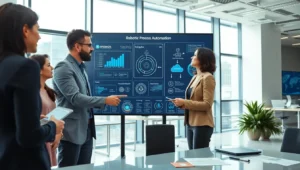Imagine a world where machines handle the heavy lifting while humans kick back with a cup of coffee. Autonomous systems are making this dream a reality, revolutionizing industries from transportation to healthcare. These smart technologies don’t just work—they think, learn, and adapt, transforming the way we live and work.
Table of Contents
ToggleOverview of Autonomous Systems
Autonomous systems function with minimal human intervention, utilizing advanced algorithms for decision-making and operation. These systems integrate artificial intelligence, enabling them to learn from their environments and adapt to changing conditions. High levels of automation characterize various domains, enhancing efficiency and safety.
In transportation, self-driving vehicles exemplify autonomous systems at work. They navigate complex traffic scenarios, make real-time decisions, and improve road safety by reducing human error. In healthcare, robotic surgery systems perform delicate procedures with precision, decreasing recovery times for patients.
Data analysis plays a crucial role in these systems. Autonomous systems rely on vast datasets to train algorithms for more accurate performance. Machine learning techniques allow these systems not only to process data but also to draw insightful conclusions. This capability drives progress across industries.
Autonomous drones represent another application. They conduct surveying tasks, monitor crops, and assist in disaster response, showcasing versatility. Their aerial capabilities provide real-time data, crucial for informed decision-making.
For industries that require repetitive tasks, automation leads to significant cost savings, elevating productivity levels. Manufacturing plants use robotic systems to streamline assembly lines, resulting in faster production rates. In logistics, autonomous delivery systems cut transport times and enhance service efficiency.
Implementing autonomous systems requires careful consideration of ethical implications. Balancing efficiency and safety with potential workforce impacts remains a priority. As these technologies evolve, so too do the conversations around responsible deployment, ensuring benefits reach society as a whole.
Key Components of Autonomous Systems
Autonomous systems rely on crucial components that enable them to perform effectively and efficiently. Two of the most significant elements are sensors and perception as well as decision-making algorithms.
Sensors and Perception
Sensors play a vital role in helping autonomous systems understand their environment. Cameras capture visual information, while LIDAR measures distances, creating detailed 3D maps. Additionally, radar detects obstacles and assesses their speed. These devices gather data in real time, allowing systems to interpret conditions accurately. Information processing algorithms analyze sensory input, enabling recognition of objects and situations. By combining data from multiple sensors, autonomous systems achieve a comprehensive perception of their surroundings, essential for safe navigation and task execution.
Decision-Making Algorithms
Decision-making algorithms guide autonomous systems in determining actions based on sensory data. These algorithms often employ machine learning techniques to predict outcomes and optimize performance. Inputs from sensors feed into these algorithms, facilitating real-time analysis. Patterns emerge from this analysis, helping systems make informed choices such as path planning and obstacle avoidance. Various algorithms, including reinforcement learning, allow systems to refine their actions over time through continuous feedback. As systems encounter diverse scenarios, robust decision-making capabilities enhance their effectiveness, ensuring efficient operation across different environments.
Applications of Autonomous Systems
Autonomous systems have made impressive strides across multiple fields, showcasing their potential to redefine industries.
Transportation and Vehicles
Self-driving vehicles demonstrate significant advancements in road safety and efficiency. These vehicles utilize advanced sensors and algorithms to interpret complex traffic situations, minimizing human error. In 2021, autonomous vehicles could prevent an estimated 94% of crashes caused by human interaction. Electric and autonomous public transport options, like buses and shuttles, improve accessibility and reduce carbon emissions. Additionally, logistics companies employ autonomous delivery vans and drones to expedite last-mile deliveries and enhance supply chain efficiency. Autonomous systems in transportation continue to evolve, paving the way for a future where efficiency and safety coexist.
Robotics and Automation
Robotic systems transform various sectors through increased efficiency and precision. In manufacturing, robots streamline operations by managing assembly lines and reducing turnaround times. According to the International Federation of Robotics, robots improved industrial productivity by 30% in 2022. Surgical robots, guided by precise algorithms, perform intricate procedures, leading to shorter recovery periods for patients. Agricultural robots aid in planting and harvesting crops effectively, addressing labor shortages and ensuring food security. Automation enhances reliability and productivity across industries, making robotics an invaluable asset.
Challenges Facing Autonomous Systems
Autonomous systems face numerous challenges across various dimensions. These challenges include ethical considerations and technical limitations that impact their implementation and effectiveness.
Ethical Considerations
Ethics play a crucial role in the development of autonomous systems. Ensuring safety remains paramount as these technologies integrate into daily life. Questions arise about accountability in the event of accidents involving autonomous vehicles. Developers must address issues like bias in algorithms, as data training can inadvertently reflect societal inequalities. Transparency in decision-making processes also contributes to public trust. Moreover, discussions about job displacement highlight the need for strategies to support affected workers. Ethical frameworks must evolve alongside technologies to ensure responsible deployment and foster societal acceptance.
Technical Limitations
Technical limitations significantly hinder the full potential of autonomous systems. Environmental factors, such as weather and lighting conditions, can disrupt sensor performance, impacting decision-making capabilities. Limited computational power restricts real-time data processing, causing delays in critical situations. Current sensor technologies sometimes struggle with object recognition in complex or ambiguous scenarios. Additionally, interoperability between different autonomous systems and existing infrastructure presents integration challenges. Cybersecurity also emerges as a pressing issue, as these systems become potential targets for malicious attacks. Overcoming these technical barriers will be pivotal to ensuring reliable and effective autonomous operations.
Future Outlook for Autonomous Systems
Autonomous systems are set to reshape industries even further in the coming years. Predictions indicate significant advancements in technology, expanding their roles across sectors. By 2030, the autonomous vehicle market is expected to reach $557 billion, highlighting the growing reliance on these systems.
Improvements in decision-making algorithms will enhance the capabilities of autonomous systems, allowing them to adapt more efficiently to dynamic environments. Machine learning developments enable these technologies to learn from new data in real time, resulting in smarter and more responsive applications. For instance, autonomous drones are projected to assist with critical search and rescue operations, improving emergency response times significantly.
Furthermore, regulations governing autonomous systems will likely evolve to address safety and ethical concerns. Policymakers are expected to create frameworks that promote responsible deployment while fostering innovation. Guidelines will need to balance public safety and technological advancement, ensuring that the benefits of these systems are maximized.
Industries such as logistics will capitalize on automation to streamline operations, as seen with autonomous delivery solutions. Enhanced delivery methods reduce operational costs and improve customer satisfaction. In agriculture, further integration of robotic technologies promises to boost productivity, addressing growing food security challenges.
Concerns about job displacement will continue to be a pivotal issue. Employers and employees alike will need to navigate workforce transitions as autonomous systems become commonplace. Strategies focused on reskilling the workforce will emerge to mitigate potential impacts on employment.
Finally, enhanced security measures will play a crucial role in the development of autonomous systems. Cybersecurity advancements will become essential to protect sensitive data and operating protocols in real time. As technology matures, these measures will support the successful integration of autonomous systems in daily life, paving the way for a more efficient future.
The rise of autonomous systems marks a pivotal shift in how industries operate. As technology continues to advance these systems are set to redefine efficiency and productivity across sectors. Their ability to perform complex tasks with minimal human intervention not only enhances safety but also paves the way for innovative solutions to longstanding challenges.
While the benefits are significant the ethical and technical hurdles must be addressed to ensure a balanced integration into society. As discussions on responsible deployment evolve it’s clear that autonomous systems hold the potential to enrich lives and transform the future of work. Embracing this change will be crucial for harnessing the full capabilities of these intelligent technologies.





